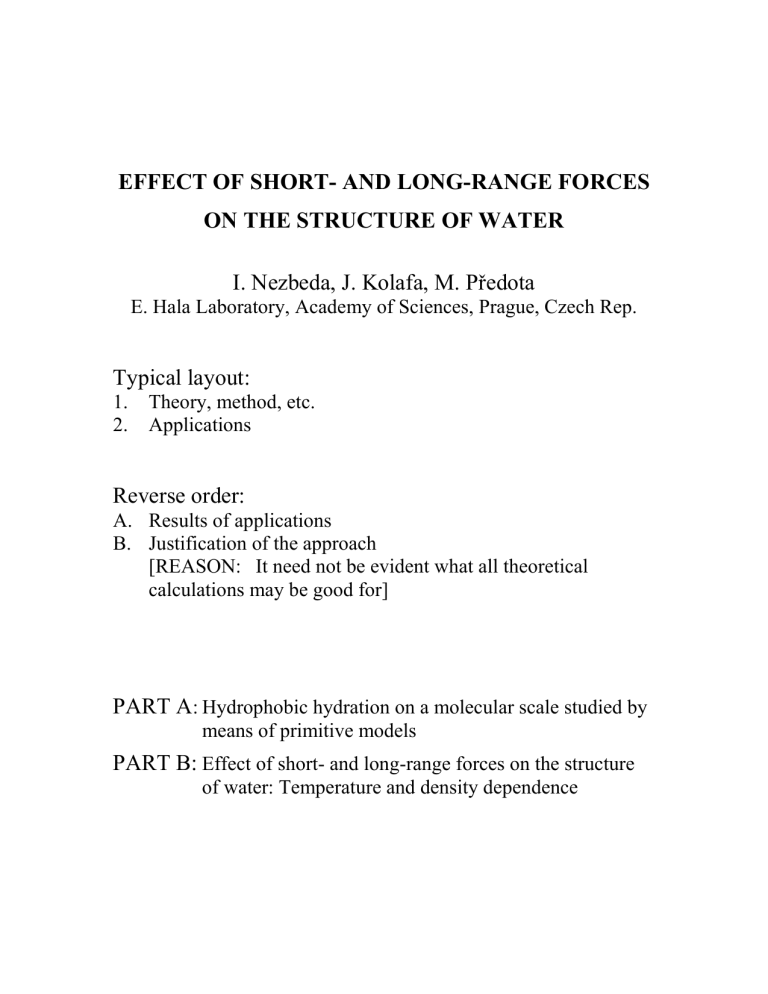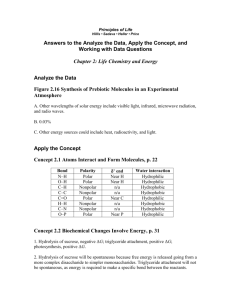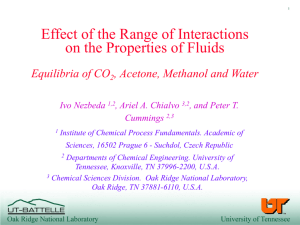A typical layout:

EFFECT OF SHORT- AND LONG-RANGE FORCES
ON THE STRUCTURE OF WATER
I. Nezbeda, J. Kolafa, M. Předota
E. Hala Laboratory, Academy of Sciences, Prague, Czech Rep.
Typical layout:
1. Theory, method, etc.
2. Applications
Reverse order:
A. Results of applications
B. Justification of the approach
[REASON: It need not be evident what all theoretical calculations may be good for]
PART A
: Hydrophobic hydration on a molecular scale studied by means of primitive models
PART B:
Effect of short- and long-range forces on the structure of water: Temperature and density dependence
J.R.Errington et al., J. Phys. Chem. B ,1998
[Molecular simulation of phase equilibria for water-methane and water-ethane mixtures]
Henry’s law constant of methane in water
...
“Equations of state for associating fluids are incapable of predicting this behavior (they predict that the solubility of hydrocarbons in water is a monotonic function of temperature
[Economou, Tsonopoulos, Chem. Eng. Sci., 1997])”.
HYDROPHOBIC HYDRATION
The term used at the molecular level to express structural changes that take place in bulk water when a single nonpolar molecule is transferred into it.
At the macroscopic level the hydrophobic effect is associated with characteristic temperature dependences:
(a) The entropies of transfer of nonpolar molecules from gas phase or a nonpolar solvent into water converge at a temperature of about 400K to approximately zero entropy change.
(b) In addition to generally low solubility of nonpolar organics and gases in water at ambient conditions, the solubility also passes through a minimum upon varying temperature.
Hummer et al. (J. Phys. Chem. B, 1998) argue that the above observations are a consequence of the behavior of the isothermal compressibility, χ
T
, of pure water.
GOAL:
To provide an explanation of the observed phenomena at the molecular level.
Comparison of the isothermal compressibility of water and nonpolar solvents as a function of temperature along their respective saturation curves (data taken from Rowlinson and
Swinton, Liquids and Liquid Mixtures)
METHODS
to study and explain hydrophobic effects:
(a) Intuitive speculations and ad hoc assumptions on the molecular structure of water and effect of nonpolar solutes thereupon (e.g. “iceberg formation”)
(b) Computer simulations (using REALISTIC potentials for
BOTH WATER AND SOLUTE)
provide invaluable information and make it possible to study even very tiny structural details, but
some properties, e.g. those defined by higher order derivatives, are computationally prohibitive
(c) Molecular theory
General problem: Lack of a simple molecular model of water or, in general, lack of any theory providing the structure of water
↓↓
ALL attempts to do theory of hydrophobic hydration have had so far
- either to resort to computer simulation results for the structure of water (Pratt and Chandler; Hummer et al.,...)
- or to ignore the structure of water at all (Wielhelm and
Battino; Pierotti; Stillinger, ...)
TYPICALLY , dilute aqueous solutions of apolar compounds are modeled by a dilute solution of HARD SPHERES (mimicking the molecules of apolar solute) in REAL WATER.
OUR MODEL:
Dilute solution of HARD SPHERES in PRIMITIVE WATER.
Primitive model: A simplest possible model which estimates the STRUCTURAL properties of the fluid at hand (e.g. hard spheres serve as the primitive model for simple fluids).
PRIMITIVE MODEL OF WATER:
Hard spheres with embedded sites of two kinds to approximate the complex force field at short moleculemolecule separations.
AVAILABLE RESULTS:
Equation of state in a closed analytic form obtained from the thermodynamic perturbation theory of Wertheim.
FOR COMPARISON we also consider a dilute solution of
HARD SPHERES in a SIMPLE FLUID (i.e. argon-like) modeled by attractive hard spheres.
The degree of presence/absence of H-bonds and the structure of the H-bond network has been the subject of numerous studies.
Nonetheless, clear and relevant consequences of all the findings for and their impact on a further theoretical development seem missing.
REASON: Hydrogen bonding is not a clear individual entity appearing e.g. in potential models.
One should thus view the H-bonds and the H-bond network as additional information on the structure supplementing the partial correlation functions.
OUR MOTIVATION:
For developing a molecular theory, the indispensable prerequisite is the knowledge of the link between the intermolecular interactions and the established structure.
In complex systems the individual contributions to the total potential are hard to be identified and it is the RANGE of the interactions which matters most.
METHOD:
Investigate separately the effect of the short-range and longrange parts of the total potential on the structure.
A realistic water-water potential (with a rigid monomer, e.g.
ST2, TIP4P, etc.), u ( R
12
,
1
,
2
)
u
LJ
( 1 , 2 )
u
Coul
( 1 , 2 ) , cannot be simply decomposed into different, physically meaningful contributions.
[REMARK: In majority of models the first Lennard-Jones (LJ) term reduces to the interaction between the oxygen sites only.]
We construct two trial potentials, one short-range (sr), u sr
( 1 , 2 )
u
LJ
( r oxygen
oxygen
)
[ 1
S ( R ' , R ' ' , r oxygen
oxygen
)] u
Coul
, and the other long-range (lr), u lr
( 1 , 2 )
u
LJ
( r oxygen
oxygen
)
S ( R ' , R ' ' , r oxygen
oxygen
) u
Coul where S is a switch function.
By setting, respectively, R ' and R ' ' to 4Å and 6Å,
the short-range potential incorporates H-bonding (and all other short-range interactions),
whereas in the long-range potential all short-range interactions are switched-off and the long-range electrostatic interactions determine the behavior of the system.







